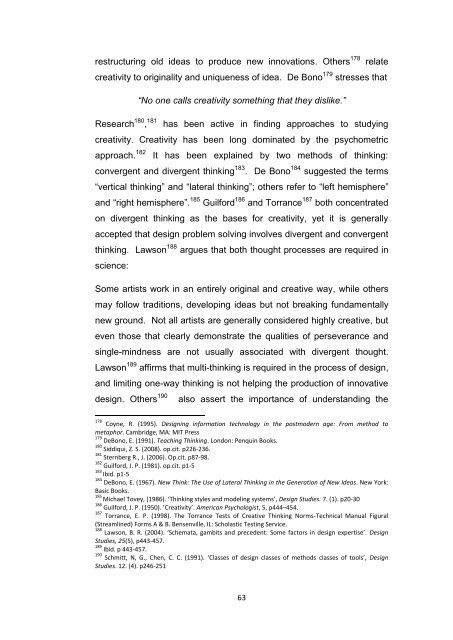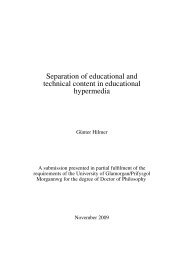framework for the implementation of a virtual design studio model in ...
framework for the implementation of a virtual design studio model in ...
framework for the implementation of a virtual design studio model in ...
Create successful ePaper yourself
Turn your PDF publications into a flip-book with our unique Google optimized e-Paper software.
estructur<strong>in</strong>g old ideas to produce new <strong>in</strong>novations. O<strong>the</strong>rs 178 relate<br />
creativity to orig<strong>in</strong>ality and uniqueness <strong>of</strong> idea. De Bono 179 stresses that<br />
“No one calls creativity someth<strong>in</strong>g that <strong>the</strong>y dislike.”<br />
Research 180 , 181 has been active <strong>in</strong> f<strong>in</strong>d<strong>in</strong>g approaches to study<strong>in</strong>g<br />
creativity. Creativity has been long dom<strong>in</strong>ated by <strong>the</strong> psychometric<br />
approach. 182 It has been expla<strong>in</strong>ed by two methods <strong>of</strong> th<strong>in</strong>k<strong>in</strong>g:<br />
convergent and divergent th<strong>in</strong>k<strong>in</strong>g 183 . De Bono 184 suggested <strong>the</strong> terms<br />
“vertical th<strong>in</strong>k<strong>in</strong>g” and “lateral th<strong>in</strong>k<strong>in</strong>g”; o<strong>the</strong>rs refer to “left hemisphere”<br />
and “right hemisphere”. 185 Guil<strong>for</strong>d 186 and Torrance 187 both concentrated<br />
on divergent th<strong>in</strong>k<strong>in</strong>g as <strong>the</strong> bases <strong>for</strong> creativity, yet it is generally<br />
accepted that <strong>design</strong> problem solv<strong>in</strong>g <strong>in</strong>volves divergent and convergent<br />
th<strong>in</strong>k<strong>in</strong>g. Lawson 188 argues that both thought processes are required <strong>in</strong><br />
science:<br />
Some artists work <strong>in</strong> an entirely orig<strong>in</strong>al and creative way, while o<strong>the</strong>rs<br />
may follow traditions, develop<strong>in</strong>g ideas but not break<strong>in</strong>g fundamentally<br />
new ground. Not all artists are generally considered highly creative, but<br />
even those that clearly demonstrate <strong>the</strong> qualities <strong>of</strong> perseverance and<br />
s<strong>in</strong>gle-m<strong>in</strong>dness are not usually associated with divergent thought.<br />
Lawson 189 affirms that multi-th<strong>in</strong>k<strong>in</strong>g is required <strong>in</strong> <strong>the</strong> process <strong>of</strong> <strong>design</strong>,<br />
and limit<strong>in</strong>g one-way th<strong>in</strong>k<strong>in</strong>g is not help<strong>in</strong>g <strong>the</strong> production <strong>of</strong> <strong>in</strong>novative<br />
<strong>design</strong>. O<strong>the</strong>rs 190 also assert <strong>the</strong> importance <strong>of</strong> understand<strong>in</strong>g <strong>the</strong><br />
178<br />
Coyne, R. (1995). Design<strong>in</strong>g <strong>in</strong><strong>for</strong>mation technology <strong>in</strong> <strong>the</strong> postmodern age: From method to<br />
metaphor. Cambridge, MA: MIT Press<br />
179<br />
DeBono, E. (1991). Teach<strong>in</strong>g Th<strong>in</strong>k<strong>in</strong>g. London: Penqu<strong>in</strong> Books.<br />
180<br />
Siddiqui, Z. S. (2008). op.cit. p226-236.<br />
181<br />
Sternberg R., J. (2006). Op.cit. p87-98.<br />
182 Guil<strong>for</strong>d, J. P. (1981). op.cit. p1-5<br />
183 Ibid. p1-5<br />
184 DeBono, E. (1967). New Th<strong>in</strong>k: The Use <strong>of</strong> Lateral Th<strong>in</strong>k<strong>in</strong>g <strong>in</strong> <strong>the</strong> Generation <strong>of</strong> New Ideas. New York:<br />
Basic Books.<br />
185 Michael Tovey, (1986). ‘Th<strong>in</strong>k<strong>in</strong>g styles and <strong>model</strong><strong>in</strong>g systems’, Design Studies. 7. (1). p20-30<br />
186 Guil<strong>for</strong>d, J. P. (1950). ’Creativity’. American Psychologist, 5, p444–454.<br />
187 Torrance, E. P. (1998). The Torrance Tests <strong>of</strong> Creative Th<strong>in</strong>k<strong>in</strong>g Norms-Technical Manual Figural<br />
(Streaml<strong>in</strong>ed) Forms A & B. Bensenville, IL: Scholastic Test<strong>in</strong>g Service.<br />
188 Lawson, B. R. (2004). ‘Schemata, gambits and precedent: Some factors <strong>in</strong> <strong>design</strong> expertise’. Design<br />
Studies, 25(5), p443-457.<br />
189 Ibid. p 443-457.<br />
190 Schmitt, N, G., Chen, C. C. (1991). ‘Classes <strong>of</strong> <strong>design</strong> classes <strong>of</strong> methods classes <strong>of</strong> tools’, Design<br />
Studies. 12. (4). p246-251<br />
63



